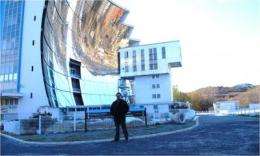CfA will play major role in mission to 'touch' the sun

When NASA's Solar Probe Plus (SPP) launches before the end of the decade, it will carry a suite of cutting-edge scientific instruments. Only one - the Solar Wind Electrons Alphas and Protons (SWEAP) Investigation - will directly sample the Sun's outer atmosphere. Designed by scientists at the Harvard-Smithsonian Center for Astrophysics (CfA), part of SWEAP will extend beyond the probe's heat shield to scoop up some of the Sun's tenuous gases.
"While the other instruments are hidden, we'll be right out there getting blasted by the Sun, literally 'touching' a star for the first time," said Justin Kasper, SWEAP principal investigator and Smithsonian astronomer.
On Sept. 2, NASA announced the funding of five SPP proposals. The SWEAP proposal will receive $67 million for instrument design and development.
Solar Probe Plus promises to transform our understanding of our home star and its effects on the solar system. It will get closer to the Sun than any other spacecraft, swooping to within four million miles.
At closest approach, the Sun will appear more than 20 times wider than it does on Earth, stretching across more than 10 degrees of the sky. It will bathe SPP in 500 times more light than we see on Earth. As a result, the probe will have to withstand temperatures exceeding 2,550 degrees Fahrenheit, as well as blasts of radiation and particles. A revolutionary carbon-composite heat shield will protect the spacecraft.
SPP will plunge through the Sun's outer atmosphere not once but repeatedly. In order to be able to observe the atmosphere under all conditions, the SWEAP Solar Probe Cup will look around the heat shield directly at the Sun. The SWEAP Solar Probe Analyzers will sit in the shadow on either side of the heat shield and make detailed measurements of the atmosphere flowing around the heat shield. On each dive, SWEAP will scoop up the main components of the corona and solar wind and determine quantities such as their speed, temperature, and relative abundance.
CfA researchers have devoted significant resources to finding materials able to not only survive a scorching, but also return useful data. That groundwork included testing materials in a furnace at temperatures up to 4,700 degrees F.
"We took enormous steps to reduce NASA's risk in accepting the proposal to fly this instrument," said CfA deputy director Roger Brissenden.
The team found two materials that could potentially be used to build SWEAP: tungsten and doped, single-crystal silicon carbide. (Silicon carbide has a wide variety of commercial uses, including drill bits and other cutting tools.)
The design and development of SWEAP represents a promising expansion of CfA's solar astronomy program. CfA is well known for its breadth of astronomical research, covering all regions of the spectrum from low-energy radio waves to harsh gamma rays. SWEAP will add direct sampling and measuring to the Center's expertise.
"This is an exciting direction for solar astronomy at CfA. I view it as a natural progression from creating X-ray optics that look at the Sun, to direct measurements," said Brissenden.
Provided by Harvard-Smithsonian Center for Astrophysics


















